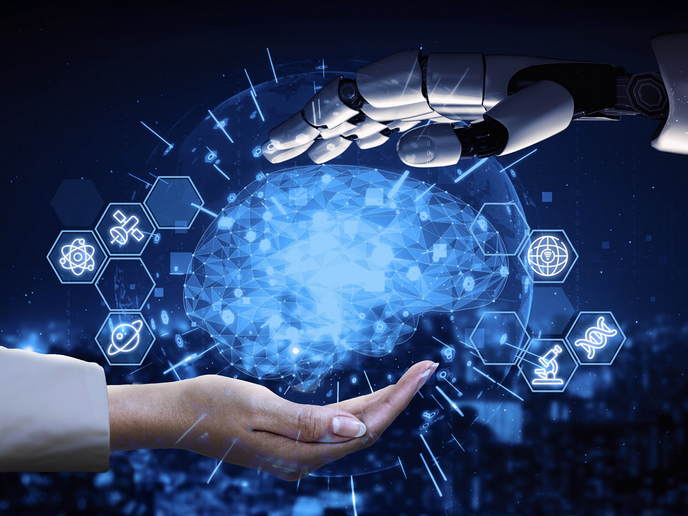Artificial intelligence: expanding scientific boundaries and enhancing innovation
The way we live and work is being transformed by artificial intelligence (AI), and scientific research is no exception. These tools can now automate tasks, analyse data, and generate insights in ways that were not previously possible. With the help of AI, researchers can now make faster progress, achieve breakthroughs more quickly and improve the quality of their work. AI works as a catalyst for scientific progress by enabling greater efficiency and extending the limits of scientific knowledge. It is particularly well suited to the process of scientific discovery and innovation and is becoming an indispensable tool for research that involves assessing large-scale scientific data sets and the generation of predictions. Automating tasks like data collection and analysis also frees researchers to focus on more creative and strategic activities. Moreover, AI is a driver of innovation in all sectors of the economy. It is expected to lead to a major boost in productivity and economic gains. AI can improve healthcare, reduce energy consumption, make cars safer, enable farmers to use water and natural resources more efficiently, and reduce the use of pesticides drastically.
EU’s strategy for AI in Europe
Given the importance of AI, the European Commission has proposed a set of actions to boost excellence in AI, and rules to ensure that the technology is trustworthy. Fostering AI excellence from the lab to the market, the AI Coordinated Plan developed by the Commission and the Member States puts forward a vision to accelerate investments in AI, to act on AI strategies for their timely implementation and to align AI policies EU-wide. An important part of the Coordinated Plan are actions financed by the European framework programmes for research “Horizon Europe”, and “Horizon 2020”. This publication presents some of the most interesting projects of these programmes that showcase the impact of AI in science. A corner stone in the European approach to the development and use of trustworthy AI is the Commission’s proposal for a legislative framework on AI (AI act). It is designed to bring legal clarity and certainty for individuals and businesses and to ensure that AI systems used in the EU are safe, transparent, ethical, unbiased and under human control.
Focus on EU-funded research
This results pack presents 15 ongoing, or recently completed EU-funded projects that highlight various applications of AI in science. It underlines how its responsible application and the use of techniques like machine learning can help science deliver innovation and address problems that would otherwise be too difficult and time consuming to solve. The projects go beyond the scientific domains typically associated with AI – engineering, medicine and computer science – to explore how it can aid scientists in the preservation of cultural heritage, in digital curation of historic documentation, in improving language-learning, in predicting natural disasters or addressing environmental challenges. Some of the initiatives strive for new scientific breakthroughs: using AI to optimise the design of new materials with desirable properties, to identify drug combinations for personalised cancer treatment, and to help collaborative robots explore inaccessible areas such as lava caves on the Moon. Another set of projects takes advantage of AI’s ability to analyse and classify a large volume and variety of data, and identify patterns and complex relationships. This is used to create fresh scientific knowledge and improve our understanding of the world and its phenomena like the behaviour of faults during earthquakes, the formation and evolution of stars or the structure of the proton. Project results thus reflect the EU’s commitment to funding the development of innovate, safe and responsible AI for research purposes. COSMIC DANCE used machine learning to understand how stars form and evolve. COG-TOM developed novel data analytical methods called cognitive tomography to better understand the human mind. CoRob-X built cooperative robotic planetary rovers with environmental perception and control systems for autonomous decision-making ability in extreme environments. DeepCube analysed big data from the Copernicus Earth Observation Programme to improve our understanding of environmental challenges. DrugComb developed mathematical and computational tools to identify drug combinations for personalised cancer treatments. F-IMAGE employed AI to classify and analyse seismic signals and understand the behaviour of faults during earthquakes. HYPERION created a framework to assess the impacts of climate change and atmospheric composition on cultural heritage sites. MOUSSE exploited the similarities between languages to create a large network of language-independent semantic representations of sentences and tackle the challenge of AI hallucinations. NNNPDF explored the inner life of the proton and its structure using machine learning techniques. RD-ADVANCE used regression discontinuity design to better quantify the causal impact of different types of policy measures. STOP applied AI to data collection and analysis to create a platform for tailored nutrition for obesity sufferers. TAXINOMISIS used machine learning and neural networks to build a risk stratification platform for patients with carotid artery disease. TopMechMat created new materials with specialised properties, using AI to optimise their design. WINDMILL employed machine learning to optimise 5G networks. VHH focused on the digital curation of film records relating to the discovery of Nazi concentration camps and other atrocity sites.



